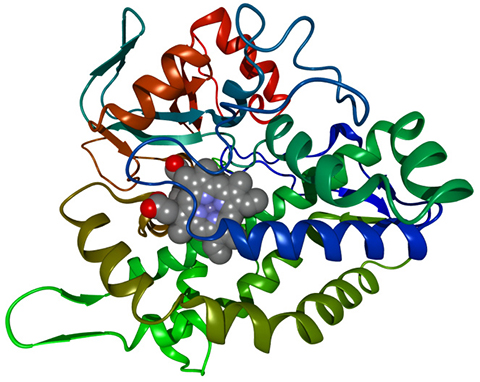Why cognition declines in Type 2 diabetes patients
For years, scientists have observed a correlation between the progression of Type 2 diabetes and the onset of cognitive impairment. A new theory about the cause of this, largely based on animal, cell and human genetics studies, implicates the cytochrome P450-soluble epoxide hydrolase, or CYP450-sEH, pathway in both Type 2 diabetes and cognitive decline.
CYP450s are enzymes that break down polyunsaturated fatty acids into epoxides, metabolites that are believed to have anti-inflammatory and cell-signaling properties. However, the sEH enzyme breaks down these epoxides into diols — molecules believed to be harmful to the cell.

Once epoxides are broken into diols, they can interfere with other normal metabolic pathways and physiological functions. Both epoxides and diols belong to the group of lipid metabolites called oxylipins.
Researchers also have found that the implicated pathway is prevalent in patients with obesity, which made a team at the University of Toronto and Sunnybrook Research Institute curious about whether an association exists between the oxylipins derived from the CYP450-sEH pathway and the three conditions: Type 2 diabetes, cognitive impairment and obesity.
According to Natasha Anita, a Ph.D. candidate at Toronto and Sunnybrook and first author of the study, the researchers were motivated to investigate this association because they had previously found “that oxylipin levels in the blood differed between people with and without small vessel disease in the brain and that the diols were associated with poorer cognitive performance and neurodegeneration.”
Knowing that diabetes increases the risk for small vessel complications and cognitive impairment, the team hypothesized that oxylipins would also be implicated in cognitive function in Type 2 diabetes patients. A report of their work was published recently in the Journal of Lipid Research.
Excluding individuals with Type 1 diabetes and neurological diagnoses, among other criteria, the researchers recruited 108 individuals with Type 2 diabetes; 51 were obese and 57 were not obese.
Using neuropsychological and verbal tests, the team assessed cognitive function, verbal fluency and mental agility. They also assessed learning and short-term and long-term memory.
In their JLR paper, the researchers wrote that their results largely agreed with the results of earlier studies in people without Type 2 diabetes. They found that increased levels of diols were associated with poorer cognitive performance.
“This is the first study to look at oxylipins in relation to cognition in Type 2 diabetes,” Anita said. “Although diabetes is an established risk factor for Alzheimer’s disease and dementia, currently there is no specific treatment for cognitive problems in this population.”
The results from this study show the CYP450-sEH pathway to be a strong potential target for therapies.
“Our current work adds to the growing number of clinical studies examining the CYP450-sEH oxylipin pathway,” Anita said. “We are hopeful that this indicates a new pharmacological target to prevent cognitive decline in this population.”
Moving forward, Anita said the team is investigating “whether these oxylipins are associated with cognitive decline over time, and whether targeting this pathway will improve cognition in people with diabetes.”
Enjoy reading ASBMB Today?
Become a member to receive the print edition monthly and the digital edition weekly.
Learn moreGet the latest from ASBMB Today
Enter your email address, and we’ll send you a weekly email with recent articles, interviews and more.
Latest in Science
Science highlights or most popular articles

How a gene spurs tooth development
University of Iowa researchers find a clue in a rare genetic disorder’s missing chromosome.

New class of antimicrobials discovered in soil bacteria
Scientists have mined Streptomyces for antibiotics for nearly a century, but the newly identified umbrella toxin escaped notice.

New study finds potential targets at chromosome ends for degenerative disease prevention
UC Santa Cruz inventors of nanopore sequencing hail innovative use of their revolutionary genetic-reading technique.

From the journals: JLR
How lipogenesis works in liver steatosis. Removing protein aggregates from stressed cells. Linking plasma lipid profiles to cardiovascular health. Read about recent papers on these topics.

Small protein plays a big role in viral battles
Nef, an HIV accessory protein, manipulates protein expression in extracellular vesicles, leading to improved understanding of HIV-1 pathogenesis.

Genetics studies have a diversity problem that researchers struggle to fix
Researchers in South Carolina are trying to build a DNA database to better understand how genetics affects health risks. But they’re struggling to recruit enough Black participants.

